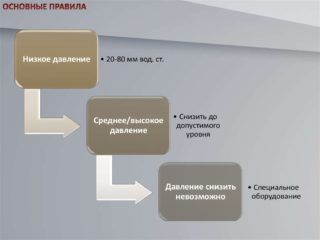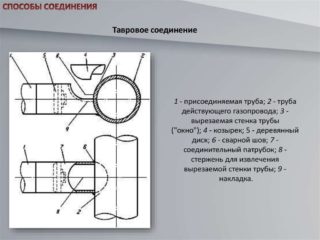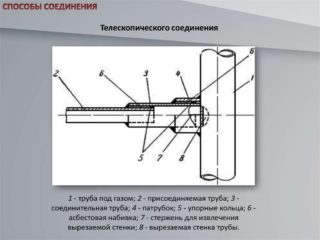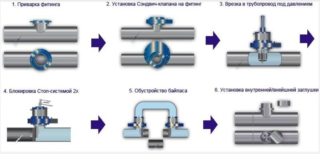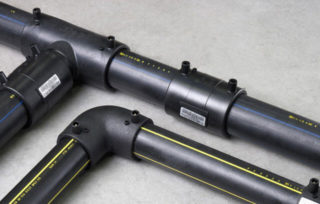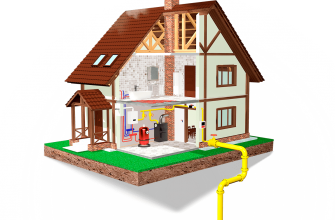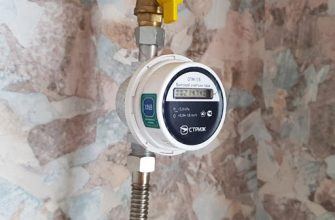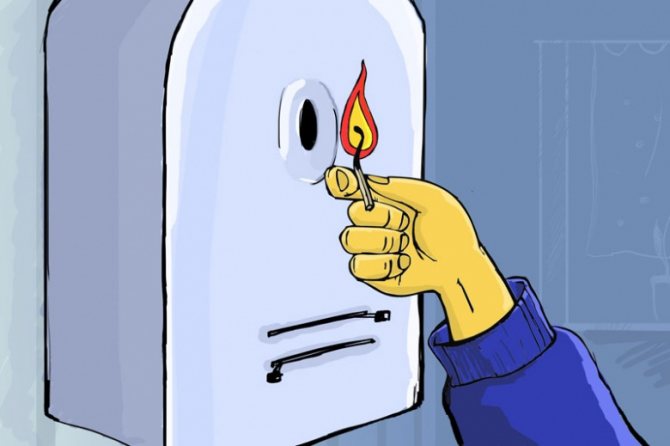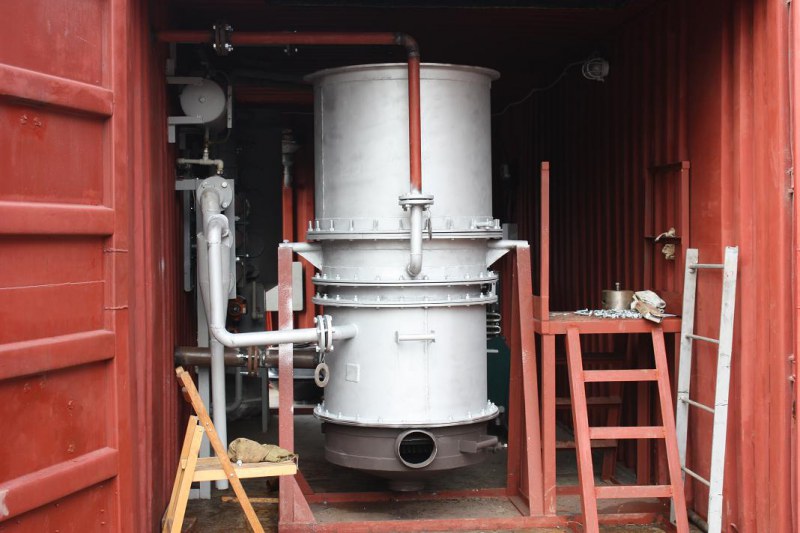For gasification of a private house, an insert into the gas pipe is required. This work is carried out only by specialized organizations. It is strictly forbidden to independently connect to the gas mains. Failure to comply with technology leads to explosions, poisoning, burns and other accidents.
- Gas pipeline throughput
- The initial stage of tapping under pressure into a gas pipeline
- Security
- Tie-in work rules
- Pressure Tapping Technologies
- Cold tap
- Welding
- Low pressure gas pipeline connection
- High pressure gas pipeline connection
- Tie-in without shutdown
- Features of tapping under pressure into a gas pipeline
- Plastic gas pipeline
- Gas pipeline from metal pipes
Gas pipeline throughput
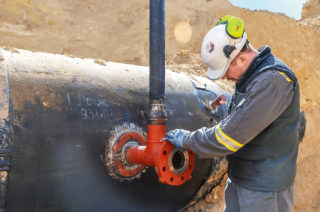
When inserting into a city gas pipeline, preliminary work is performed - calculation of throughput. In this case, the purpose of the gas pipeline is of fundamental importance. For domestic needs, they equip a simple system with low pressure. In such conditions, calculations are performed according to the simplest formulas, taking into account only the pipe diameter and the average pressure in the network.
Qmax = 0.67 Du² * pwhere
- Qmax - bandwidth;
- Du - nominal pipe passage - internal diameter indicated in the documents;
- p - the sum of the working pressure in the gas pipeline and 0.1 MPa.
In the calculations, average values are used - pressure surges, the magnitude of the friction force arising during movement is not taken into account.
If the connection is made to lines with a higher pressure, other parameters must be taken into account. The formula is usedQMax = 196.386 × D² × P / Z × Twhere:
- QMax - maximum throughput;
- D - internal diameter of the gas pipeline;
- P –The sum of the working pressure and 0.1 MPa;
- Z - coefficient of gas compressibility;
- T Is the temperature of the supplied gas in Kelvin.
From here, the dependence of the throughput on temperature is clearly visible. To increase this parameter, it is necessary to maintain a stable temperature of the supplied fuel and insulate the gas pipeline.
To calculate the capacity of the network for industrial needs, much more complex calculations are used according to the equations of gas movement and equations of continuity.
The initial stage of tapping under pressure into a gas pipeline
The owner submits the following documents to Gorgaz:
- gas supply system design - approved;
- application - the document is certified by the head of the territorial department personally;
- passport and identification code of the owner of the building;
- connection permission - issued by the architectural planning department;
- registration certificate for the house - you can submit a copy confirmed by a notary;
- photography - the picture is taken during a topographic survey of the site, the entire infrastructure is captured in the photo: water supply, heating system, sewage; the picture is assured by the gas service workers.
If the construction has not yet been completed, the architectural design of the building and the permit for its construction are attached to the package. If the total area of the house exceeds 300 m², you will need a thermal calculation of the building, a situational plan for the allotment on a scale of 1: 5000 and the consent of the neighbors on the site to connect to the gas pipeline. The latter is necessary if part of the network will have to be laid across their territory.
In addition to the documents for a permit for tapping under pressure into a main or city gas pipeline, information is needed about the installed gas appliances: a boiler, a gas stove, a gas meter, a boiler. You need to have in your hands the data sheets of all products, certificates, permission for their use (they are obtained from the city administration of the gas economy), contracts for the maintenance and repair of devices.
For fuel combustion, a sufficient air supply and a system are required to get rid of combustion products: hoods, chimneys, ventilation ducts. If the building is ready, the owner needs to obtain an inspection certificate for ventilation and chimney systems. If the task is under construction - ventilation project.
Connection made without the registration of the necessary documents and permits entails administrative penalties. If the gas injection has led to damage to the pipeline, criminal liability is threatened.
Security
The next stage is carried out by the forces of the invited team. Before connecting to the gas pipeline, you need to:
- draw up a diagram of the connection angles;
- choose a tie-in method, calculate the procedure and method for reducing pressure, determine ways to maintain the indicator at the desired level;
- calculate and select the required amount of materials, tools, rescue and protective equipment;
- close taps, valves, plugs on the connected pipe;
- stock up on the required amount of water to prevent fire or fire.
Before the tie-in, a control test of the pipes, the connected system and the air outlets is carried out.
Tie-in work rules
- The injection into a gas pipe under high or low pressure is carried out only by employees of the relevant organization and only with a certificate confirming qualifications. These are very dangerous jobs.
- Connection to the network with low pressure is carried out at values not exceeding 20–80 mm Hg. To do the same at high or medium pressure, you must first reduce the value to an acceptable one. Disconnecting devices are used, a bypass is installed in dead-end gas pipelines.
- If it is impossible to reduce the pressure, use specialized equipment. Such work is much more difficult and expensive.
- When welding or gas cutting, it is necessary to maintain the pressure at the working area in the range from 40 to 150 kg / cm.
With strict adherence to safety standards, the likelihood of accidents and emergency situations is reduced to a minimum.
Pressure Tapping Technologies
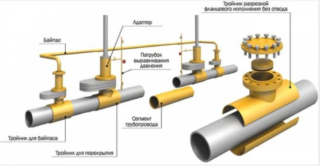
Connection to the gas main is performed with a complete shutdown of the gas supply or at reduced pressure. The second method is used more often, as it shortens the time of work and does not create problems with the supply of fuel to already connected consumers.
Cold tap
The essence of the method is the installation of control valves before the actual connection. The technology is pretty simple.
- They clean the gas pipe from rust and dirt, install a clamp that exactly matches the pipe diameter and fasten it with bolts.
- A valve is fixed to the collar flange. The valve is tightly closed prior to drilling.
- A drill with a cover is attached to the valve. The fastening is practically airtight due to the seals. The drill must be long enough to fit through the valve and pipe wall.
- Drill the main pipe and connect the branch. In this case, gas leakage is excluded, and the pressure drop becomes insignificant.
Cold tapping is one of the safest installation methods.
Welding
An injection into a low-pressure gas pipeline without shutdown is performed through a branch pipe.The taps are connected to the main gas pipeline with an end connection, a T-insert, telescopic.
T-joint diagram:
- A branch pipe is made - a connecting element of the corresponding dimensions. One end of it should be connected to the main, the second - to the new gas pipeline. A window is made in the branch pipe to perform manipulations, but this fragment - the visor - is saved.
- The future hole is marked on the main pipe. A steel bar is welded to the marked fragment so that it can be pulled out later. Then the disc is cut. In this case, a 5 mm jumper is left. The gas ignites during cutting. It is extinguished by coating the cut site with clay.
- The branch pipe is mounted and welded to the main line and to the gas pipeline to be installed.
- A wooden disk coated with clay is fixed in the branch pipe to prevent the possibility of an explosion.
- With the help of a rod, a wooden plug and a cut-out pipe wall on a steel rod are removed. Immediately fix the visor to the asbestos sheet.
- The attached pipe is blown through to get rid of the gas-air mixture. Then the visor is welded on. A steel plate is mounted on top.
This method is considered obsolete today.
Low pressure gas pipeline connection
The technology is similar.
- The pipes are cleaned of insulation, heated, and the junction is marked. The pipe to be connected is cut and the edge is processed.
- The branch is placed on the main gas pipeline and welded.
- Then a technological hole is cut in the connected pipe - a visor. And already through it, a hole is made in the main pipe - a penny. The fragment is not removed, but is held in place by a thin bridge. Extinguish the flame, if it appears, smearing the cut with clay.
- The prepared visor is laid with at least 3 mm thick moistened asbestos.
- The next stage is performed very quickly: the welder knocks out a penny, and the second worker immediately covers the window with a visor. The cracks are immediately rubbed with asbestos. The penny is taken out. To do this faster, you can weld a rod to it.
- The visor is welded, the seams are cleaned. The connection is isolated.
If, according to the scheme, pipes are welded relative to each other at an angle, use a tie-in with a steeply curved or bent branch into the gas riser.
Modern tools allow extremely thin seams and cuts. At the same time, gas practically does not come out, ignition is excluded.
High pressure gas pipeline connection
The injection under pressure into the gas pipeline is made with a coil or T-joint. If necessary, connect a new gas pipeline not to the end of the existing one, install an additional adapter piece: a branch pipe, a tee, a coupling with a valve.
All manipulations are performed after preliminary pressure reduction in the working area. This is done using disconnecting devices. If the system is looped, gas distribution points are used - with a safety relief valve and a bypass. In order not to provoke an increase in pressure in the previous section, a "candle" gas pipeline is installed. The excess gas is burnt.
Welding will be performed according to the flow chart. They are developed for each connection process.
Tie-in without shutdown
In the first case, a coupling and a pipe with a flange made for the pipe diameter are welded to the line. A valve with a chamber is fixed to the flange. A hole in the main pipe is cut through the sleeve, a fragment of the wall and the cutter itself are taken out through the chamber. The valve is immediately closed, after which a new gas pipeline is welded to the flange.
The second method is more complicated, but provides more reliable operation. A branch pipe is welded to the line, inside which a sleeve is fixed to the wall with the base of the pipe.A pin, a stem with a cutter are screwed in through the bushing, then machine oil is poured.
A PGVM is mounted on the flange, and then a hole is drilled with a milling cutter for the outlet. The cut disc is removed along with the cutter and the rod, and the hole is closed with a rubber stopper. When the gas is opened, the plug is wrapped in a branch pipe, and the PGVM is removed. The cork is scalded around the perimeter.
After the completion of the work, the seams are checked for tightness using a soapy emulsion and only then they are isolated.
Features of tapping under pressure into a gas pipeline
Plastic gas pipeline
Welding plastic pipes takes less time and costs less. Connect products using polyethylene and steel inserts. The length varies from 80 to 100 cm.
The technology is simple: a steel insert is heated to 60 C, and a plastic structure is placed on it. The latter should dock very tightly, with effort, and a low temperature only increases the contact density.
Connection via a ball valve is possible. Before assembly, fittings and heaters are mounted into the network, then the overhead crane is welded. A drill rod is fixed on its branch pipe, with its help a hole is drilled after pressing the resulting assembly. Then the gas is released through the gas outlet hose, the equipment is removed from the branch pipe and the drill rod is removed. Together with the cutter, you need to remove both the cut disc and the chips.
At the last stage, the branch is welded with a coupling to the free end of the branch pipe.
Tapping of plastic pipes is allowed at a line pressure of no more than 10 bar.
Gas pipeline from metal pipes
Connection to steel pipes is made in different ways. Common to all techniques are 2 points.
- Welding and cutting metal requires a much higher temperature than cutting plastic. However, to ignite a gas, not only temperature is required, but also oxygen. It is not in the main pipe, but when blue fuel seeps out during cutting, it mixes with oxygen and ignites. Gas concentration is low. To extinguish it, before cutting, the area is covered with clay, and in the process, the procedure is periodically repeated.
- After installation, be sure to check the tightness by smearing the new seams with soapy water. If there is a leak, soap bubbles appear.
After connecting the new gas pipeline to the main, an act of work is drawn up. The document is certified with signatures. In the future, it is possible to conclude an agreement with the gas supplying organization only if there is a connection certificate.


